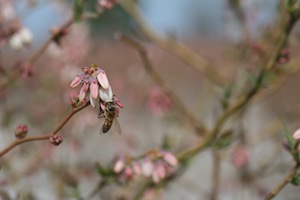Bee biodiversity boosts blueberry crop yields
Research from North Carolina State University shows that blueberries produce more seeds and larger berries if they are visited by more diverse bee species, allowing farmers to harvest significantly more pounds of fruit per acre.
“We wanted to understand the functional role of diversity,” says Dr. Hannah Burrack, an associate professor of entomology at NC State and co-author of a paper on the research. “And we found that there is a quantifiable benefit of having a lot of different types of bees pollinating a crop.”
The researchers looked at blueberries in North Carolina because it is an economically important and well understood crop that relies on insect pollination.
Within the blueberry fields, the researchers identified five distinct groups of bee species: honey bees, bumble bees, southeastern blueberry bees, carpenter bees and a functionally similar collection of species that they termed small native bees.
The researchers found that for each group above one, farmers saw an increase of $311 worth of yield per acre. For example, if two bee groups pollinated a field, the boost would be $311 per acre; for three bee groups, the boost would be $622 per acre, and so on.
“For North Carolina blueberries as a whole, we calculate the benefit of each group to be approximately $1.42 million worth of yield each year,” Burrack says.
“We think the benefit stems from differences in behavior between bee groups, in part depending on the weather,” explains Dr. David Tarpy, an associate professor of entomology at NC State and co-author of the paper. For example, southeastern blueberry bees work well regardless of inclement weather, whereas honey bees only perform at their best on calm, warm, sunny days.
“This can make a big difference, since blueberries bloom in March and April in North Carolina,” Burrack says. “That means the weather can swing from great to awful, as we saw this year.”
There is some research showing that having native, flowering plants near blueberry fields can increase native bee populations over time, but the researchers are now planning to see what role crop management can play in fostering bee diversity at crop sites.
“We’ve shown that there is a real financial benefit associated with biodiversity,” Burrack says. “The next step is to figure out how to foster that diversity in practical terms.”
The paper, “Bee species diversity enhances productivity and stability in a perennial crop,” was published May 9 in the open-access journal PLOS ONE. Lead author of the paper is Shelley Rogers, a former graduate student at NC State who received an NSF Graduate Research Fellowship to support this work.
Photo credit: Hannah Burrack
NC State University






